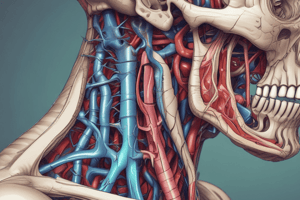Podcast
Questions and Answers
What is the primary function of the larynx in relation to the trachea?
What is the primary function of the larynx in relation to the trachea?
- Preventing food and liquids from entering (correct)
- Producing sound and voice
- Controlling breathing and airflow
- Regulating pitch and tone
What type of tissue makes up the vocal cords?
What type of tissue makes up the vocal cords?
- Cartilaginous tissue
- Epithelial tissue
- Nervous tissue
- Muscle tissue (correct)
What is the term for the opening between the vocal cords?
What is the term for the opening between the vocal cords?
- Glottis (correct)
- Larynx
- Pharynx
- Trachea
What is the term for the production of sound and voice?
What is the term for the production of sound and voice?
What is a common condition that affects the vocal cords?
What is a common condition that affects the vocal cords?
What is the function of the intrinsic and extrinsic muscles in the larynx?
What is the function of the intrinsic and extrinsic muscles in the larynx?
Flashcards are hidden until you start studying
Study Notes
Location and Function
The larynx, also known as the voice box, is a vital organ located in the neck, above the trachea (windpipe). It plays a crucial role in:
- Producing sound and voice
- Protecting the trachea by preventing food and liquids from entering
Structure
The larynx consists of:
- Cartilages: thyroid, cricoid, and arytenoid
- Ligaments: connect the cartilages and provide support
- Muscles: intrinsic and extrinsic, responsible for movement and vocal cord function
- Vocal cords (folds): two bands of muscle tissue that vibrate to produce sound
Vocal Cord Function
- The vocal cords are responsible for:
- Producing sound and voice
- Regulating pitch and tone
- Controlling breathing and airflow
Laryngeal Functions
- Respiration: the larynx helps regulate breathing by opening and closing the glottis (the opening between the vocal cords)
- Phonation: the production of sound and voice
- Protection: the larynx prevents food and liquids from entering the trachea
Clinical Significance
- Laryngeal disorders can affect speech, breathing, and swallowing
- Common conditions include:
- Laryngitis: inflammation of the vocal cords
- Hoarseness: abnormal voice changes
- Vocal cord polyps or nodules: growths on the vocal cords
- Laryngeal cancer: a type of cancer that affects the larynx
Location and Function
- The larynx, or voice box, is located in the neck above the trachea.
- It produces sound and voice and prevents food and liquids from entering the trachea.
Structure
- The larynx consists of cartilages (thyroid, cricoid, and arytenoid) and ligaments that connect and support them.
- It has intrinsic and extrinsic muscles responsible for movement and vocal cord function.
- The vocal cords are two bands of muscle tissue that vibrate to produce sound.
Vocal Cord Function
- The vocal cords produce sound and voice, regulate pitch and tone, and control breathing and airflow.
Laryngeal Functions
- The larynx regulates breathing by opening and closing the glottis (the opening between the vocal cords).
- It produces sound and voice through phonation.
- It prevents food and liquids from entering the trachea through protection.
Clinical Significance
- Laryngeal disorders can affect speech, breathing, and swallowing.
- Common conditions include laryngitis (inflammation of the vocal cords), hoarseness (abnormal voice changes), vocal cord polyps or nodules (growths on the vocal cords), and laryngeal cancer (a type of cancer that affects the larynx).
Studying That Suits You
Use AI to generate personalized quizzes and flashcards to suit your learning preferences.



